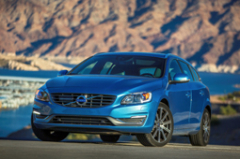LAS VEGAS – If Volvo had not built up a certain amount of capital in the market and within the automotive press, it would have been written off as dead a few years ago.
Ford purchased the company in 1999 for $6.4 billion. There were a few good years but then as misfortune befell Ford, Volvo’s fortunes in terms of product declined resulting in the company being put up for sale in 2008. It was eventually sold to Geely Automobile of China in 2010.
Now, after four years and an $11 billion influx of capital, Volvo seems ready to reassert itself in this market. It debuted what it called its 60 cluster of automobiles: the Volvo V60, S60 and XC60. Well, actually the XC60 was not here.
The existing models have been refreshed for 2014 and their look will remain unchanged for 2015 model year. The sheet metal has been tweaked a little bit from the A-pillar forward but the cars remain unmistakably Volvos.
Still, previously visible washer nozzles are now under the hood, the radar cover has been redesigned to mesh better into the grille and the grille itself has been redesigned. The Ironmark badge is bigger. There are also more wheel design choices which can differentiate the look of the vehicles.
But the real news is under the hood and it is not the repositioned washer nozzles. Volvo’s much awaited family of Drive-E engines is ready for roll out; initially, two four-cylinder engines will be available in the U.S. market. One of them with a single turbocharger produces 240 horsepower while the second with a supercharger and turbocharger working in tandem produces 302 horsepower.
Still available are Volvo’s five and six cylinder engines but eventually they’ll be phased out in favor of the Drive-E powertrains. Right now the 60 cluster of vehicles with all-wheel-drive will be equipped with Volvo’s five and six cylinder engines and the front-wheel-drive models get the Drive-E powertrains.
Only front-wheel-drive models of the S60 and V60 were here as Volvo unveiled its new Drive-E power plants. The four cylinder engines are lighter by almost 100 lbs., more compact but just as powerful as six and eight cylinder engines. They have lower emissions and better fuel economy, the 240 horsepower version getting 37 mpg on the highway.
Friction reduction including heat management and an electric water pump as well as stop start brake technology aids in the reduction in fuel consumption.
The 302 horsepower four cylinder is the first of its kind in the market, using both a supercharger and a turbocharger. The former is most efficient at injecting massive amounts of air into the combustion chamber while the turbocharger is far more efficient at doing the same thing at higher speeds. The result is a powerfully responsive engine at any speed.
This technology is nothing new; it was first used in WWII airplanes like the P51. At the time quiet and smoothness was not a prerequisite. The main focus was power. Today, Volvo uses more than 50,000 pages of code to make the two blowers work in harmony and do so quietly without a noticeable transition between the two.
By the way, both engines were mated to a new (for Volvo) eight-speed automatic transmission.
The first half of the day was spent driving the S60 with 302 horsepower. The engine was rhythmically smooth, gear shifts were imperceptible and power was more than impressive. On a long straight two-lane highway we passed a slower moving vehicle, quickly getting over, passed it and then back into the lane. A glance at the speedometer showed that the car had reached 111 mph and was still pulling.
The S60 Drive-E could have gone faster; the top speed is electronically limited to 127 mph because the tires are not rated for a higher speed.
We drove a V60 (sport wagon) back in winds that gusted to 40 mph. Although windy conditions could be seen as we drove along, they could not be heard or felt until we got out the car. The V60 held its track too. We never had to adjust steering because of the really strong winds.
Volvo’s Eco+ function shuts off the engine when the car is coming to a stop. In other words, the engine will shut off as any of the Drive-E powered cars slows to 4 mph and comes to a stop. The engine brake will also disengage as the engine speed drops to idle when there is no pressure on the accelerator, putting the vehicle in a coast.
The vehicles had a new instrument cluster. A thin film transistor screen had three settings: Elegance, Eco and Performance each with a different background color and instrumentation. The infotainment system of course had satellite radio and a navigation system. The test car also had adaptive cruise control.
As usual, the seats were outstanding. Not only does the car provide full internet browsing when not moving, it had its own iCloud for cyber storage. Safety systems include the ability to bring the vehicles to a full stop when an obstacle, a pedestrian or a cyclist are detected.
What’s more, Volvo said these two Drive-E power plants are the first offerings of the new engine family. There will be diesels but no decision has been made on whether they’ll be offered in this market. And the engines are already configured to work in hybrid applications. Electrification was Volvo’s phrasing.
Pricing starts at $33,300 for the S60 T5 Drive-E FWD, $38,150 for the T6 Drive-E, the V60 T5 Drive-E FWD starts at $33,300 and it will be $35,750 for the XC60 T5 Drive-E. A yellow caution light is that Volvo intends to sell the same car with two different engine families. That can confuse the consumer. The quicker the Swedish automaker can switch over to its Drive-E engines for all of its vehicles the better.
Frank S. Washington is editor of AboutThatCar.com.




